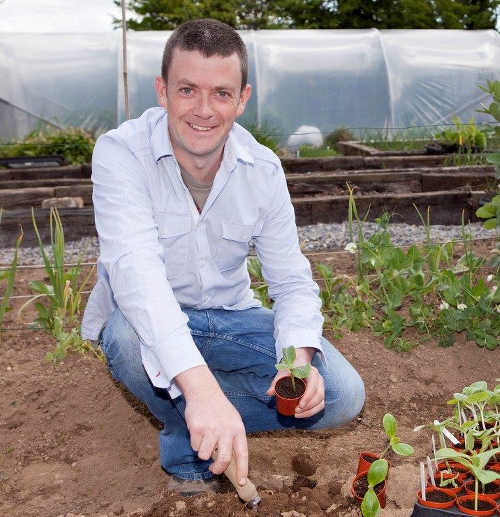Grow It Yourself - March
 I am all for taking a decent break from the veg patch in the winter months, and I do very little between late November and February. There are lots of things I could be doing if I was that way inclined, and I know of GIYers that visit the veg patch daily in those times – continuing to sow, grow and harvest despite the short days and inclement weather. I am not one of those growers. Apart from occasional trips to pick some carrots, parsnips, kale or leeks, I visit the veg patch rarely in winter.
I am all for taking a decent break from the veg patch in the winter months, and I do very little between late November and February. There are lots of things I could be doing if I was that way inclined, and I know of GIYers that visit the veg patch daily in those times – continuing to sow, grow and harvest despite the short days and inclement weather. I am not one of those growers. Apart from occasional trips to pick some carrots, parsnips, kale or leeks, I visit the veg patch rarely in winter.
Rather than a continuous 12 months of work, I prefer to see my veg patch year as about 9 months of work with a focus on growing food for winter storage so that I can take a break. It takes all sorts of course, but to my mind, the winter months are for hibernation – both for me and for my veg patch. We both work hard enough for the rest of the year.
Every year, I wonder will I have the desire to get going at all when spring arrives. This tends to worry me a good deal, particularly in January and February. But as March arrives, the sap rises in nature and I can feel the excitement mounting in me all over again at the prospect of food growing.
The food opportunities that the veg patch offers are laid out before me like a blank canvass. Seeds arrive by post and I thrill at the thoughts of putting my hands in to the soil again.
Perhaps it is some desire that rests deep in my DNA and is triggered by the time of year, but suddenly I have a deep craving for eating green leafy things. Thank goodness for spring cabbage then, which is making its first appearance this month from the polytunnel.
Since seed sowing is my favourite of all the GIY activities, March is a very happy month indeed. Last month I did a couple of sowings of the long-season veg like tomatoes, peppers and aubergines, but these only felt like minor skirmishes.
I always feel like I am practically coaxing things to life in February – using artificial heat and light to bring things on. In March, things are easier and we can get really stuck in – the days are getting longer and day time temperatures are increasing. The sap is rising.
 Things to do this Month - March
Things to do this Month - March
To Do
Continue to prepare ground – there is still time to prepare a plot to grow veg this year. Fork or rake over existing beds, breaking up large clods of earth. Cover new seedlings with fleece if a frost is due. Start your daily slug patrols and lay beer traps. Don’t let new-season weeds take over – get on top of them with weekly hoeing.
Sow
Indoors: lettuce, aubergine, peppers, cucumbers, celery, celeriac, sweet corn, basil, leeks, summer cabbage, cauliflower, Brussels sprouts, parsley, courgette, French beans.
Sow outdoors or under cover: broad beans, red cabbage, carrots, cauliflower, spinach, kale, Brussels sprouts, onions, leeks, turnip, peas, radishes, early lettuce, asparagus.
Plant your first early seed potatoes, as soon as weather conditions allow.
Harvest
This month you could be enjoying (from the ground and from storage) onions, leeks, parsnips, potatoes, some varieties of lettuce, mint, sprouting broccoli, kale, rhubarb, chard, the first of the spring cauliflowers and cabbage, and spinach (perpetual, spinach beet).
Recipe of the Month – Spring Greens and Gammon Soup
I’ve used this Barney Desmazery recipe to use up leftover ham (or you can cook the gammon from scratch) – it’s a wonderful broth to celebrate the first spring cabbage. Serves 4.
Ingredients:
• 450g piece gammon, soaked overnight
• 2 bay leaves
• 2 medium onions, sliced
• 2 tsp paprika
• 2 large potatoes, peeled and chopped into small chunks
• 225g spring greens, roughly chopped
• 450g can cannellini beans, drained and washed
Directions
Put the gammon in a large pan with the bay leaves, onions and about 1.5 litres of cold water or enough to cover. Bring to the boil, then reduce the heat and simmer gently for about 1½ hrs.
Drain the gammon, reserving the cooking liquid. When the gammon is cool enough to handle, trim away the skin, and shred the meat.
Return meat to the pan with the reserved cooking liquid, paprika and potatoes. Cover and simmer for 20 mins or until the potatoes are cooked.
While the potatoes are cooking, trim away the stalky bit from the greens and finely shred the leaf. Stir the greens and beans into the stock and continue to cook for about 10 mins until cooked.
Season to taste and serve ladled straight from the pan.
Tip of the Month – Sowing Spuds
The soil in which you are planting potatoes requires a generous application of well-rotted farmyard manure, compost or seaweed before planting (ideally a couple of weeks before).
Sow first earlies in mid March (St Patrick’s Day traditionally) in single rows, 15cm deep, 25cm apart and 45cm between rows. Maincrop spuds are sown in mid to late April. Increase spacing to 35cm.
It is vitally important to include potatoes in your crop rotation as they are susceptible to disease if grown in the same ground year on year.
Check earlies in mid June to see how they are getting on. Earlies will be ready about 14 weeks after sowing. Maincrops take 18 weeks. I typically leave my earlies in the ground and dig as required. They do fine in the ground until September at which point we move on to maincrop.
Maincrop can stay in the ground until the first frosts – lift them then and store in hessian sacks.
For a GIY video tutorial on growing spuds check out www.giyireland.com/videos/detail/potatoes
About GIY
GIY is a not-for-profit organisation that aims to create a healthier, more sustainable world where people grow their own food. We inspire and support people to grow food more successfully by bringing them together to share advice, tips and ideas. There are approximately 50,000 people involved in the GIY movement in Ireland, which is proudly supported by Woodies DIY.
For more information check out www.giyireland.com
Michael Kelly is a freelance journalist, author and founder of GIY Ireland.
© GIY Ireland 2014 – all rights reserved.





There are currently no comments
Leave a comment
Not a member? Register for your free membership now!
Or leave a comment by logging in with: